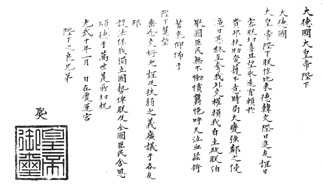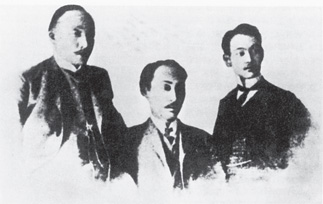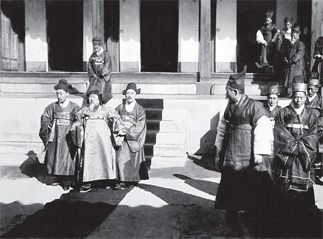Painful, significant landmark

Deoksu Jungmyeongjeon was part of Deoksu Palace, where Korea was forced to sign a treaty with Japan giving up its diplomatic rights. The building was one of the few European-style structures within the palace. [JoongAng Ilbo]
Sometimes embarrassing historical moments get pushed into obscurity as a nation tries to forget its dark past. A perfect case is Deoksu Jungmyeongjeon, a European-style building that was once part of Deoksu Palace. The building served as a venue for King Gojong of the late Joseon Dynasty to receive foreign diplomats and hold occasional banquets. It was also the royal house’s library.
It is located next to Habib House, the residence of the United States Ambassador, in downtown Seoul. A small ally beside the Chongdong Theater leads to this building. It’s somewhat obscured by its surroundings. One might take the building for a restaurant. It has no particular features to make it a stand out as a landmark. In fact, Jungmyeongjeon is a building that may only catch the eye of a trained architect, someone who could recognize features of the early modern architectural style of the two story building that also has a basement.
Nevertheless, this very building was a silent witness when Korea gave up its foreign policy rights, handing them over to Japan by signing the Japan-Korea Protectorate Treaty of 1905, also known as the Eulsa Treaty. It was a pivotal step, paving the way for Korea’s eventual full submission to Japan as a colony five years later.

A secret letter from King Gojong written to Germany’s Emperor tells how Korea was forced to give up its diplomatic rights.
The building caught fire in 1925, leaving only the outer walls intact. It was later rebuilt. After the end of Korea’s colonial days, the building was returned to Lee Eun and Lee Bang-ja, both members of the royal house that no longer existed by then. Then it was sold to the Seoul Union that used it until 1960. The building was sold to a private company in the 1970s and since then has changed hands several times.
Despite its place in modern Korean history, the Seoul city government saw little need to buy back the building until the Culture Ministry did.
Under the direction of the Cultural Heritage Administration of Korea, the building is currently undergoing renovations, but detailed plans for use of the building still need to be hammered out. “Right now we are focusing on reconstructing the inside of the building to its original form,” said Choi Gil-seob, an official of the Cultural Heritage Administration. “We are playing with various ideas right now to best utilize the building as it certainly has historical value.”
The official explained that over the years, while serving as an office building, the interior was altered. Old blueprints were used to restore the inside of the building. “If the building becomes a museum, whatever goes inside it will probably reflect the building’s importance in modern history,” said Choi.

Lee Jun, Lee Sang-yeol and Lee Wi-jong, who were sent on a secret mission to the Hague to plead the country’s cause at an international conference.
Before last year it was owned by Chongdong Theater, which donated the building to the Cultural Heritage Administration. The construction process is expected to last till next year and 2.3 billion won ($2.2 million) has been set aside for the job.

King Gojong is helped by court officials. [JoongAng Ilbo]
Experts say the seeds of resistance to Japanese rule were sown then. The signing of the treaty became a catalyst for various anti-Japanese protests and underground independence movements. In 1907 the King sent a secret mission to an international peace conference held in The Hague, the Netherlands, to tell other nations that the treaty with Japan was signed under duress without the consent of the King and the nation as a whole. A member of that secret delegation, Lee Jun, committed suicide over the failure of the mission. Before the delegation left for The Hague, King Gojong handed a secret letter to the delegation at Jungmyeongjeon. The incident also led to the forceful abdication of King Gojong.
Japan forced King Gojong to give way to his second son Sunjong Korea’s last king who only stayed in power for three years before announcing in August of 1910 that the country had conceded all of its ruling powers to Japan.
Jungmyeongjeon was part of the Deoksu Palace complex that at times encompassed the whole Jeong-dong area, but as the palace became fragmented during Japan’s reign, there is little left now that hints at the building’s royal origins. Perhaps next year, when restoration is complete, citizens will get a better sense of a place that holds a significant place in Korean history.
By Brian Lee Staff Reporter [africanu@joongang.co.kr]










with the Korea JoongAng Daily
To write comments, please log in to one of the accounts.
Standards Board Policy (0/250자)